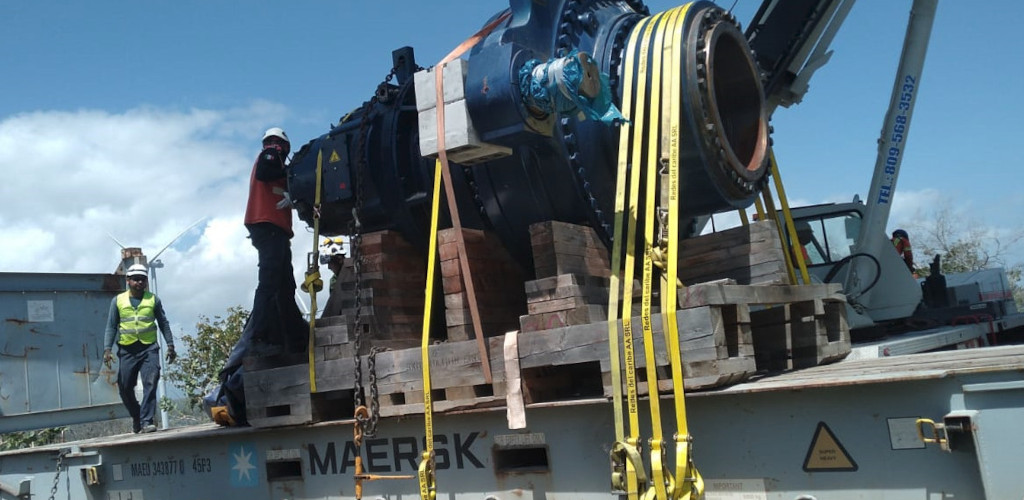Jul 05 | 2024
DP World, MPL Among Companies Active in Region’s Leading Logistics Hub

By Simon West
From Issue 4, 2024 of Breakbulk Magazine, industry leaders from DP World and Maersk Project Logistics assess the opportunities in the Dominican Republic, a leading logistics hub in the Caribbean.
(4-minute read)
While tourists to the Dominican Republic may be seduced by powdery white beaches and crystal-clear Caribbean waters, breakbulk professionals are more likely to be enthused by the country’s emergence as a world-class logistics hub.
Sharing the island of Hispaniola with Haiti, the Dominican Republic’s auspicious geographical location offers easy access to major markets throughout the Americas and Europe – one of the reasons Dubai-based DP World chose to establish a foothold in the country more than two decades ago. Speaking to Breakbulk, Manuel Martinez, CEO for DP World Dominicana, described the country as the Caribbean’s “premier trade and logistics center” and a “critical juncture” for cargo redistribution across the U.S. and Central and South America.
 “The Dominican Republic’s strategic location is just one of its many strengths,” Martinez said. “The country has also upheld a stable political and social environment and a robust economy that serves as a benchmark for the region. With a legal framework that fosters foreign investment, over 800 international companies have set up operations in the country’s free zones aiming to diversify their operations.”
“The Dominican Republic’s strategic location is just one of its many strengths,” Martinez said. “The country has also upheld a stable political and social environment and a robust economy that serves as a benchmark for the region. With a legal framework that fosters foreign investment, over 800 international companies have set up operations in the country’s free zones aiming to diversify their operations.”DP World’s facilities are centered around the Punta Caucedo peninsula, about 25 kilometers from capital city Santo Domingo, and include a deepwater port, a world-scale logistics center and the recently launched Punta Cana Air Cargo Hub (PCACH), a joint venture between DP World and the Punta Cana Free Trade Zone.
Caucedo Port is the country’s newest port and one of several in the country capable of processing breakbulk and project cargo – others include Santo Domingo, Boca Chica and Rio Haina in southeast Santo Domingo province and Puerto Plata in northern Puerto Plata province. Caucedo can handle some 2.5 million twenty-foot equivalent units (TEUs) and boasts the deepest draft in the Caribbean, allowing it to accommodate larger vessels than neighboring facilities. An adjacent economic zone offers three million square meters of land to companies seeking to relocate their logistics operations.
The port also features a dock dedicated to feeder ships, project ships and general cargo vessels that provide weekly connections throughout the Caribbean. In the last two years, DP World Dominicana has handled more than 250,000 tons of breakbulk, much of it arriving from Asia, Brazil and Turkey as it moves through the Caribbean.
“In July, we’re receiving a new Super Post Panamax crane, which will add greater capacity and flexibility to our operations, and a new fleet of electric trucks that will reduce emissions. We also plan to develop 102,000 square meters of warehouses and 500,000 square meters of land for loose cargo and RoRo within the next 18 months,” Martinez said.
The PCACH, meanwhile, which began operations in late-2023, is located at the Punta Cana International Airport and houses an air cargo terminal, logistics center, warehouses, manufacturing facilities, a fuel supply terminal, a maintenance and repair workshop for aircraft and a general service building. The hub has just welcomed the arrival of its first freighter aircraft, which is transporting bulk cargo on a weekly Toronto - Mexico - Ecuador - Punta Cana route.
The nation’s ports and air cargo hubs are connected to major commercial and industrial centers by an extensive highway network, but, as is common throughout the region, roads between coastal regions and inland areas often pose challenges for the movement of heavy cargo.
“The road infrastructure is not that bad,” said Alvaro Muñoz, business manager at Comodality Dominicana, the local division of Denmark-based forwarder Comodality Group. “Road maintenance is not so good, but the network covers the whole country and potholes do get fixed. We have police assistance for any car or truck with problems on the roads, which is much better than many other countries in Latin America and the Caribbean.”
“It’s All About Energy”
Solid infrastructure is vital for the Dominican Republic’s flourishing project market – the largest in the Caribbean, according to Robert Fernaine, regional head of Latin America and the Caribbean at Maersk Project Logistics (MPL).
While many Caribbean countries focus on tourism and agriculture, the Dominican government has opted to diversify its economy and support the buildout of industrial sectors including manufacturing, mining and energy. Investment in infrastructure such as public transport, roads and ports has further boosted the need for heavy transport logistics, Martinez said.
_1.jpg) In the power sector, the country has embarked on a clean energy drive in a bid to generate 25% of its electricity from renewables by 2025 and 30% by the end of the decade, a target the government believes will call for private sector investments of US$5.4 billion. Spending this year on green energy projects is expected to reach US$1.3 billion, according to the government’s national energy commission, the CNE. Some 26 largescale renewable projects are currently being built; eight of those are slated for start-up in the coming months, the CNE said in a June update.
In the power sector, the country has embarked on a clean energy drive in a bid to generate 25% of its electricity from renewables by 2025 and 30% by the end of the decade, a target the government believes will call for private sector investments of US$5.4 billion. Spending this year on green energy projects is expected to reach US$1.3 billion, according to the government’s national energy commission, the CNE. Some 26 largescale renewable projects are currently being built; eight of those are slated for start-up in the coming months, the CNE said in a June update.While solar photovoltaic (PV) projects dominate the mix, wind farms are also being built, such as the 50-megawatt (MW) Cacaos project in northern María Trinidad Sánchez province and the 49- MW Vientos del Jovero project in eastern El Seibo province.
The Dominican government also wants to expand natural gas capacity in a bid to reduce costly imports. Construction is already underway on the Manzanillo gas project, set to be the largest in the country and among the biggest in the region. The 1.2-GW project in northwest Monte Cristi province will comprise three gas-fired power plants as well as a liquified natural gas (LNG) storage facility and pipelines.
“It’s all about energy,” Fernaine said. “If you look at the Caribbean region then the Dominican Republic is the strongest breakbulk and project-related country. It’s an energy, project-based destination country. Wind farms, thermoelectric, solar projects – that is where the country is growing. We’re quoting for a few things that are happening. We have transformers that are under quotation, and we are participating in thermoelectric expansion.”
Since its launch in May 2023 following the integration of Danish project logistics specialist Martin Bencher, MPL has sought to gain a toehold throughout Latin America and the Caribbean, offering special cargo transport and project management services to both new and existing customers.
The forwarder has also been transporting humanitarian aid to Haiti, often using the Dominican Republic’s better-equipped ports and air cargo facilities as a launchpad for urgent deliveries. Haiti – the poorest country in the Western Hemisphere – has struggled to recover from a devastating earthquake in 2010 that killed tens of thousands of Haitians, with widespread poverty, political instability and gang violence exacerbating the crisis.
“We have a very strong relationship with a number of agencies from the United Nations that we are supplying a lot of equipment to,” Fernaine said. “The Dominican Republic is sometimes used as a support base for the flow of goods into Haiti, but our first option is to go directly to avoid any transhipment or additional cost. We have done a few air charters as well from the U.S. into Haiti delivering humanitarian cargo directly. That had been stopped but we are now resuming again.”
While continuing to support its neighbor with the relief efforts, the Dominican Republic remains steadfast in its bid to expand its logistics infrastructure and lure more foreign investment. FDI inflows to the country last year jumped 7.1% to US$4.4 billion, the largest recipient country in the Caribbean, according to a June report from the U.N.’s trade and development agency UNCTAD.
Challenges remain though, with Martinez pointing to the ongoing crisis in the Red Sea and the severe drought in Central America that has forced the Panama Canal to slash daily transits. “As with any significant logistics hub, any disruption that occurs in the regional or global supply chain represents a challenge,” the CEO said. “But we are actively collaborating with our key partners – particularly the maritime lines that traverse the Panama Canal – to manage these disruptions and mitigate these challenges.”
DP World will be exhibiting at Breakbulk Americas 2024 on 15-17 October at the George R. Brown Convention Center, Houston.
TOP PHOTO: MPL supports transports projects across Latin America & the Caribbean. CREDIT: MPL
SECOND: Manuel Martinez. CREDIT: DP World
THIRD: MPL delivers project cargo in the Caribbean. CREDIT: MPL
